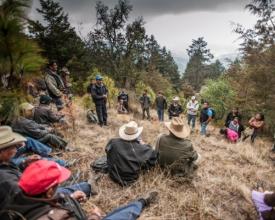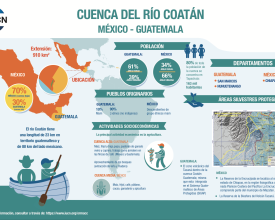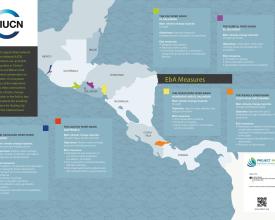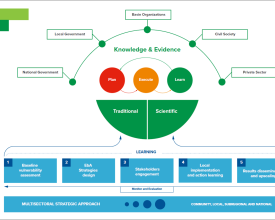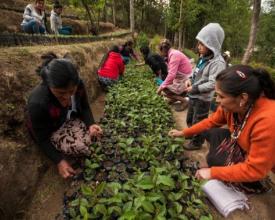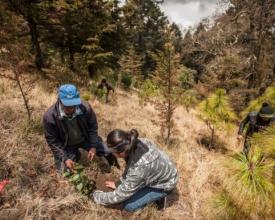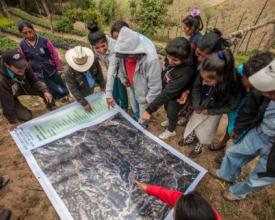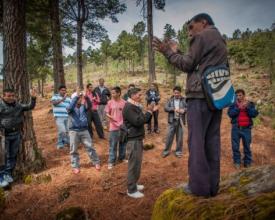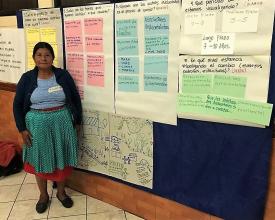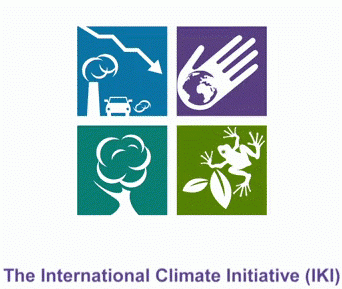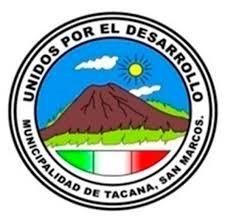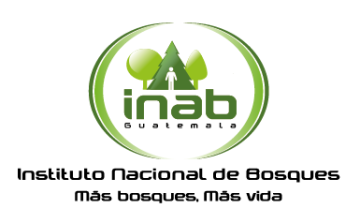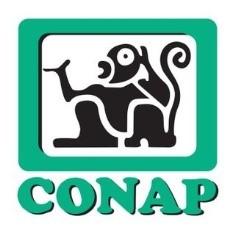
Strengthening water security and water governance of indigenous communities in Guatemala
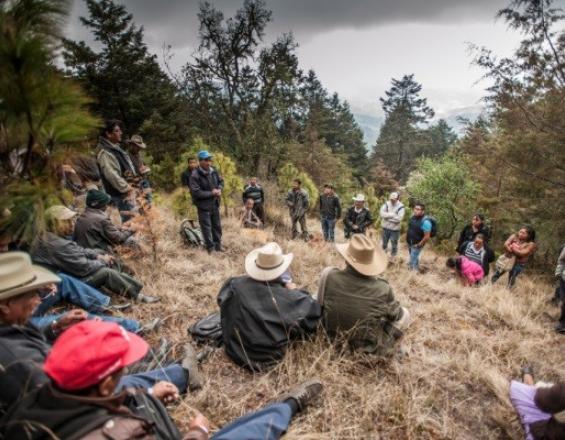
The Esquichá River micro-watershed (38 km2) in the upper part of the Coatán River Basin is experiencing high levels of deforestation and erosion, especially in water recharge zones. The 20 local communities are seeing more landslides and crop losses due to climate variability.
Ecosystem-based adaptation (EbA) is promoted through a process of governance strengthening and "action learning" aimed at diversifying productive practices and restoring degraded ecosystems for greater food and water security of communities. The solution combines increased dialogue, capacities and knowledge, with increasing environmental and social resilience, to achieve local impacts and up scaling.
Efforts contribute to strengthening the Esquichá River Micro-watershed Council as a platform for governance and the management of natural resources, while promoting agro-forestry systems and restoring forest cover in water catchment areas through natural regeneration, reforestation and community forestry nurseries.
Context
Challenges addressed
- The water flows of the Esquichá River have decreased, while the micro-basin's geo-physical characteristics, namely steep slopes and scare forest cover in areas where water sources are found, limit water recharge.
- There is overexploitation of soil and forests (only 21.5% of the micro-watershed has forest cover) and unsustainable management of natural resources. Trees are cut mainly for construction, firewood, and crops without soil conservation measures.
- The majority of households are indigenous and are in a situation of poverty or extreme poverty; community structures exist but with limited capacities. There is a need for greater local empowerment and a common strategic vision for adaptation to climate change.
- There is a high risk of landslides and loss of crops due to storms, strong winds, frosts or droughts, seriously affecting local livelihoods, housing and productive infrastructure, and food security.
Location
Process
Summary of the process
This solution combines local capacities, knowledge and alliances to foster socio-environmental resilience and achieve local impacts and up scaling. The building blocks work in paralIel. It promotes EbA through "action learning" (BB1) and governance strengthening (BB3) processes aimed at improving and diversifying productive practices and restoring degraded ecosystems (BB2) for greater food and water security in indigenous communities of the Esquichá River. Therefore, there are 3 BBs: 1) Capacities and knowledge; 2) Socio-environmental resilience; and 3) Governance.
This process begins by strengthening the existing organizational base (BB1 and 3), giving support to municipalities, Community Development Councils (COCODEs), Communal Forestry Nursery Commissions, and a strong agenda with the Esquichá River Micro-watershed Council. Through sensitization and participatory workshops (BB1 and 3), an EbA plan is consolidated within the Esquichá Micro-watershed Management Plan, which aims to ensure water production, diversify production and stabilize slopes (BB2) as adaptation measures. In addition, there is close coordination with the municipal government of Tacaná, with CORNASAM as a departmental platform, and with the central government.
Building Blocks
"Action learning" and monitoring to increase capacities and knowledge
There is a continuous process of capacity building with local communities and institutions to identify, design and implement ecosystem-based adaptation (EBA) measures, generating evidence on their benefits, and creating conditions for their sustainability.
The process includes not only theoretical workshops but also: technical assistance, field practices, exchange tours and a diploma for municipal technicians. The process is collaborative and participatory, and the experience was of great learning and empowerment for the groups involved, especially women.
Some examples of activities include:
- Application of the CRiSTAL tool - "Community-based Risk Screening Tool - Adaptation and Livelihoods" with municipal and community representatives
- Along with 16 communities and the Municipality of Tacaná, the forest restoration strategy was designed and implemented, supporting community nurseries
- Communities are accompanied in the management of forest incentives for sanitation, reforestation and protection actions.
- Local leaders are trained in methodologies to monitor the effects of forest restoration and protection of water sources on food and water security.
Enabling factors
- The Municipal Council of Tacaná provided accompaniment to the communities in the process of access to forest incentives.
- IUCN had 10 years of experience in the territory and local technical staff.
- There is excellent community leadership, which increases their willingness to dialogue, learning and the search for solutions.
- There is an awareness of climate change, since extreme events in previous years have impacted several communities, damaging both their assets (crops, housing, productive infrastructure) and the water resource.
Lesson learned
- Having knowledge on water security and specific technical information on EbA facilitated the processes of awareness raising, participation, adoption of community agreements and implementing targeted actions, which in turn helped to avoid the dispersion of resources.
- Since there is an organizational base in the communities, in the form of Communal Forestry Nursery Commissions and in some cases Community Development Councils (COCODEs), the process of "learning by doing" is greatly facilitated since, through these local platforms, it is possible to promote the exchange of experiences and knowledge, and collective learning.
- Local empowerment through social participation is key to ensure the implementation and continuous improvement of a Monitoring and Evaluation system, as well as to obtain lessons learned. Communities are convened thought their leaders. This approach has greater chance to ensure sustainability in time and replicability of EbA measures.
Implementation of scalable EbA measures to increase forest cover and water availability
Based on the vulnerability analysis and by common agreement, the communities prioritized several EbA measures in order to increase their resilience:
- Protection and restoration of water recharge zones. Includes reforestation on municipal or communal lands with water sources; protection of community pine forests where the largest areas of natural forests (Abies guatemalensis) in good condition are found; reparation of communal forests affected by pests; and reforestation of areas without trees adjacent to natural forests. For these actions that improve connectivity and forest cover, access to forest incentives is also promoted.
- Establishment (1) and strengthening (15) of community forestry nurseries, to support reforestation actions.
- Agro-forestry systems and good practices: Productive systems on 16 farms are optimized and diversified, incorporating timber and fruit trees to improve soil conservation, productivity and food security.
- Recovery of lands affected by landslides: Agroforestry systems as well as access to forest incentives for the recovery of areas damaged by storms are promoted.
The communities of the microbasin embraced these measures and support their implementation with important technical resources.
Enabling factors
- The Tacaná Municipal Council gave support to communities for access to forest incentives.
- IUCN had 10 years of experience in the territory and local technicians.
- There is excellent community leadership, which increases their willingness to dialogue, learning and the search for solutions.
- There is an awareness of climate change, since extreme events in previous years have affected several communities, damaging both their assets (crops, housing, productive infrastructure) and the water resource.
Lesson learned
- Key factors for the implementation of EbA measures were: a strong organizational base, community agreements, social participation and leadership from local authorities (both indigenous and municipal).
- To ensure that EbA was able to demonstrate an initial impact in communities and in this way, create confidence in the adopted strategy, the first step was to promote reforestation in the upper parts of the micro-basin (water source areas) or in areas affected by landslides, as well as community work around forestry nurseries. These actions helped to consolidate the concept that forest cover is "an insurance" in the face of climate change.
- Valuing the ecosystem services of the basin helped to see adaptation as a task for all communities, in order to obtain benefits for both the Esquichá micro-basin and for other communities located further down in the Coatán River basin.
Consolidating inclusive governance for adaptation
The stakeholders of the Esquichá River micro-watershed face governance challenges for adaptation, such as insufficient coordination between the community, municipal, departmental levels, and the sectors. The Council of the Esquichá River micro-watershed, gathers municipalities, communities, and the Communal Nurseries comissions. A multilevel technical support is provided to ensure sustainability:
- With technical support, the Committee has learned about EbA measures and has incorporated them into the micro-watershed Management Plan. Technical assistance has been provided to identify efforts for its implementation and financing (e.g. forestry incentives). This is how the Committee, now with greater organizational capacity, has had an impact on other instances (Municipal and Departmental Councils, INAB) and has achieved the allocation of funds for the EBA measures.
- Technical assistance provided on management of communal forest nurseries.
- Implementing a gender approach that actively involve women in capacity building and decision making. Women have been trained in communication skills, to improve their leadership abilities (https://www.iucn.org/node/29033).
- Support for the Municipality of Tacaná to integrate adaptation measures into the local planning (Municipal Development Plan).
Enabling factors
- Under Guatemala’s System of Development Councils, the Esquichá River Micro-watershed Council is made up of the Community Development Councils of the micro-basin communities, which allow to work in an organized manner and influence higher levels (eg. Municipal Councils).
- CORNASAM, created in 2004 as a platform for departmental coordination, has allowed for an articulated dialogue between the municipalities of San Marcos, basin organizations and micro-watersheds.
- Gender approach to actively involve women in decision making and capacity building.
Lesson learned
- The improvement of local women leadership skills, has a long-term impact in the management of natural resources and the social cohesion of communities. Women felt they had a lot to contribute; having taken ownership of these spaces, their confidence to act in other circles also increased. When consulted, women indicated that after gender and communication training, they have “lost the fear of expressing themselves in meetings where there are men," noting that they are aware of their right to participate as key actors in promoting forest restoration in water recharge areas as a climate change adaptation measure.
- Governance for adaptation must promote open, equitable, respectful, and effective participation, so that planning and decision-making mechanisms are enriched by inclusive participation.
- The EbA measures implementation builts upon community participation and local leadership. Communities are convened thought their leaders. This approach has greater chance to ensure sustainability in time and replicability of EbA measures.
Impacts
- Increase in 10 hectares per year of forest cover resulting from project actions that include training, technical assistance and follow-up of reforestation campaigns.
- Agroforestry systems in 16 plots optimized with fruit and timber trees to improve soil conservation, productivity and food security.
- Promotion, through communal forestry nurseries, of the participation of women in decision-making spaces and community organizational structures.
- Active participation of 420 people (280 women and 140 men, including youth) around 16 communal nurseries that produce plants for the reforestation of water recharge areas, prioritized as community water sources.
- Production of 53,000 native species plants (some in danger of extinction), for timber or with a function in water capture, of which 10,000 a year are destined to the restoration of water recharge zones.
- Social capital and participatory governance mechanisms strengthened, with better-informed communities and greater organizational capacity.
- Municipality of Tacaná allocates budget for the restoration of water recharge zones and incorporates EbA in the updating of the Municipal Development Plan.
Beneficiaries
- 16 indigenous communities (Mam ethnic group; ~500 people)
- 2039 families in the Esquichá micro-basin (~12125 inhab.)
- Municipalities of Tacaná and San José de Ojetenam
- Coordinator of Natural Resources and Environment of San Marcos (CORNASAM)
Sustainable Development Goals
Story
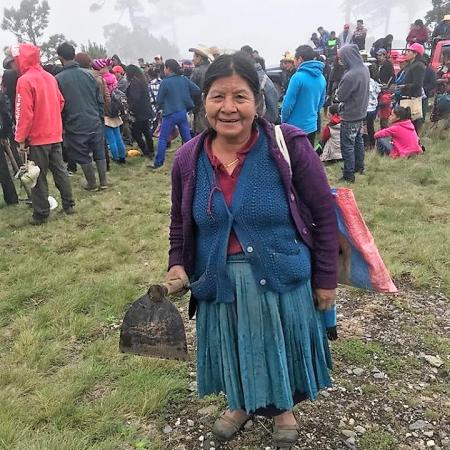
In the Esquichá River basin, communities in the upper part, together with municipal representatives, identified the climatic threats to which they are exposed and prioritized the restoration of water recharge zones as the main EbA measure. In order to obtain the necessary inputs for the restoration efforts, one of the first steps was to strengthen the communal forestry nurseries in the area. This work promoted the participation of women, being women who ended up occupying many of the highest positions in the boards of the Communal Forestry Nursery Commissions, and also in other key decision-making spaces.
Mrs. Valentina Ortiz from the community of Tojchoj Grande, Tacaná (San Marcos), President of community's Forestry Nursery Commission and member of the Esquichá River Micro-watershed Council, tells of her experience and of the learning and empowerment achieved in her community.
“By being able to integrate into organized groups, we empowered ourselves to be able to take action to respond to climate change within our community and our micro-watershed, and the most important thing is to involve many people, including women, youth and all of us who are affected by climate change.
Before, us women had no participation and we had a lot of energy wanting to participate, but we were not allowed in these spaces. We are the ones who see the needs and the problems, how we are affected by climate change, for instance the reduction of water for human consumption and for our needs. We see the low yields due to droughts or heavy rains, we can see that the amount of production goes down and we see it in the amount of food we make, and that inspires us to carry out activities to prepare ourselves for these events.
Now there is a lot of participation of women, young people, and I feel happy because we have been part of breaking that fear of young women and telling them “if I could, then they can do it too”. And we will continue working so that this work is multiplied and other communities and later our children or grandchildren can see the results of all the work that we did within the nurseries and the Microbasin Council, such as the reforestation days where more than 500 people participated in getting trained, and all of this we can put into practice within our community and micro-watershed.”
